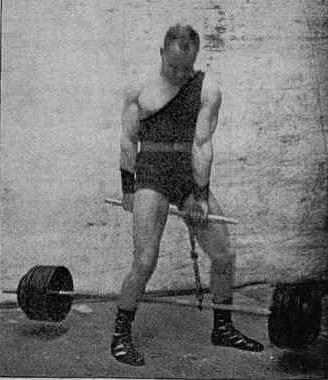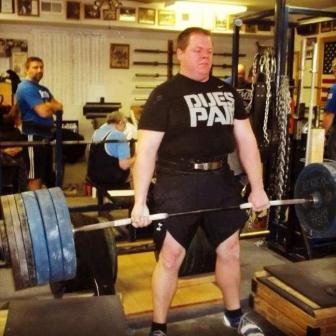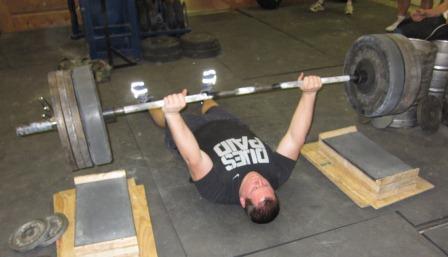Kennedy Lift
by Al Myers

Here's an Old Time Strongman performing a variation of the Kennedy Lift by utilizing a Hand and Thigh Bar attached to a regular bar.
I’ve received a few questions regarding the nature of the “Kennedy Lift” following my announcement of the Dino Gym Challenge, which includes a lift by this name. It was one of the lifts that Warren Lincoln Travis included in his “Challenge to the World”, in which he challenges 20 repetitions at 700 pounds in 10 seconds. In his Challenge WLT calls it instead the Two Hand Grip Lift, but it is the same lift. Other sources originally called it the Hands Alone Lift. I’m sure the reason for this name was to different it from the Hand and Thigh Lift – meaning no parts of the implement should be touching the body besides the hands (thus Hands Alone), as illustrated in the picture with this story.
The Kennedy Lift is nothing more than a partial Jefferson Lift (or straddle deadlift). I’ve heard lifters in the past refer to the Jefferson Lift AS the Kennedy Lift , but this is only partially true (pun intended). The Kennedy Lift is done by straddling the weight with the lift being close to lockout. The range of movement is reported to be several inches to just clearing the floor, depending on sources. The Kennedy is not an official lift of the USAWA, but is one worthy of it. It will be performed in the Dino Gym Challenge as an exhibition lift that will count in the meet scoring (allowed under the rules of the USAWA). If it is well received by those in attendance, I may submit it for lift approval in the USAWA. It has the “history” to be an official All Round lift for sure.
I had to do some “digging” in my files to find a good reference to the origins of the Kennedy Lift. Some of the information on the internet is not entirely true, so I had to make some decisions as to what I thought were the facts. The following piece was written by Warren Lincoln Travis, titled “My 40 years with the World’s Strongest Men”, in which he talks about how the Kennedy Lift came to be. I tend to believe what WLT says in his writings, and here it is:
About forty years ago, at the height of the new wave of strong man popularity, the late Richard K. Fox, then publisher of the Police Gazette, the leading sporting journal of America, had a 1000 pound dumb-bell cast, but it was not in the shape of the dumbbells today. It was more like a massive block of iron. He offered a very valuable gold medal and title to the first man to lift this 1000 pound weight. At that time there was a man known as James Walter Kennedy who was athletically inclined and developed. He was an oarsman and general athlete, leaning, however, more toward the strong man. He was about 6 feet tall and weighed around 190 pounds, had jet black curly hair and moustache and at a time was a special officer at the Globe Museum at 298-300 Bowery, New York City. Kennedy took a notion that he could lift this 1000 pound dumbbell with his hands and he began to train with a big whiskey cask, not using whiskey in it, but water, sand and rock as he gained strength. In other words, he used the Milo Bar Bell system of gradually increasing weight as he improved in his strength. The first time he tried lifting the 1000 pound weight he failed but some time later he succeeded. His style was to straddle the weight and have one hand in front of his body grasping the weight and the other hand grasping it in the rear of his body, this position being known as the Hands Alone Lift. His body was erect with the exception that the knees were bent about 2 or 3 inches. – by Warren Lincoln Travis
I envision the technique to be very similar to how most lift the Dinnie Stones, using the straddle style. I think it very fitting that the origins of this lift was described by Warren Lincoln Travis, and must have been one he appreciated, as he included it in his “Challenge to the World”. James Walter Kennedy was 29 years old when he accomplished winning this challenge set forth by Richard K. Fox. He came from Quincy, Illinois. The date of this strongman debut of the Kennedy Lift was January 25th, 1890. The “1000 pound dumbbell” was actually a 1030 pound solid iron block with handles affixed to the top 24 inches from the ground.
At the Dino Challenge we will be using a bar set up on blocks so weight can be added to that of a lifters’ preference and the rules of the USAWA can be followed in adding weight over three attempts. It will be done according to the rules of the Jefferson Lift, except the bar will be at a higher position than the floor. The bar height will be a set height (yet to be determined) so that it will NOT just be a “lockout lift” like the Heavy Lifts are.

